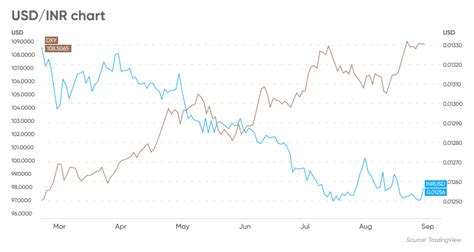[Heading] U.S. Dollar vs. Indian Rupee: A Comparative Analysis

The Essence of Currency Exchange
In the tapestry of global finance, currency exchange stands as a cornerstone, facilitating international trade, investments, and tourism. Among the myriad currency pairs, the exchange rate between the U.S. dollar (USD) and the Indian rupee (INR) commands significant attention. This article delves into the intricacies of USD to INR conversion, exploring historical trends, influential factors, and future projections.
Historical Trends and Market Fluctuations
Over the past decade, the USD to INR exchange rate has exhibited notable fluctuations, shaped by a confluence of economic, political, and global events.
| Year | Average USD/INR |
|---|---|
| 2013 | 59.26 |
| 2014 | 62.36 |
| 2015 | 64.57 |
| 2016 | 66.74 |
| 2017 | 64.37 |
| 2018 | 69.04 |
| 2019 | 71.81 |
| 2020 | 73.75 |
| 2021 | 74.22 |
| 2022 | 79.71 |
[Subheading] Factors Influencing Currency Exchange Rates
A multitude of factors influence the exchange rate between the USD and INR, including:
- Interest rates: Changes in interest rates in the U.S. and India impact the relative attractiveness of their respective currencies for investment.
- Economic growth: Strong economic growth in one country can lead to an appreciation of its currency against the currency of a slower-growing country.
- Inflation: Differences in inflation rates between the two countries can affect the purchasing power of their currencies.
- Political stability: Political stability in a country can boost confidence in its currency, leading to its appreciation.
- Trade flows: The balance of trade between the two countries also influences the exchange rate.
Key Trends and Future Projections
Looking ahead, several key trends are expected to shape the USD to INR exchange rate in the coming years:
- Convergence of interest rates: As India’s economy continues to grow, the gap between U.S. and Indian interest rates is likely to narrow, reducing the impact of this factor on the exchange rate.
- Strengthening economic ties: The deepening economic ties between the U.S. and India, driven by trade, investment, and cultural exchange, are expected to stabilize the exchange rate.
- Global geopolitical developments: Global geopolitical events, such as wars or economic crises, can have ripple effects on currency markets, including the USD to INR exchange rate.
Market Insights and Future Trends
[Subheading] Key Insights
- The USD to INR exchange rate is expected to remain volatile in the short term, influenced by geopolitical uncertainties and market fluctuations.
- Over the long term, however, the exchange rate is likely to stabilize as India’s economic growth converges with that of the U.S.
[Subheading] Future Trends and Growth Potential
- Increased trade volume: The expanding trade volume between India and the U.S. is expected to drive demand for both currencies, leading to a more stable exchange rate.
- Digitalization and currency markets: The rise of digitalization is revolutionizing currency markets, potentially reducing transaction costs and increasing the efficiency of cross-border payments.
- Emerging financial technologies: Innovative financial technologies, such as blockchain-based solutions, have the potential to disrupt traditional currency exchange models and create new opportunities for growth.
How to Stand Out in the Currency Exchange Market
[Subheading] Competitive Strategies
- Offer competitive exchange rates: Providing competitive exchange rates is essential for attracting customers and gaining market share.
- Provide excellent customer service: Friendly and efficient customer service is crucial for building customer loyalty and trust.
- Leverage digital tools: Utilize digital tools, such as mobile apps and online platforms, to enhance customer convenience and streamline operations.
- Target specific niches: Focusing on specific customer niches, such as travelers or businesses, can help drive growth and establish a unique brand identity.
FAQs
[Subheading] Frequently Asked Questions
- What is the best time to exchange USD for INR? The best time to exchange currencies varies depending on market conditions. However, generally, it is advisable to monitor the exchange rate trend and make transactions when the rate is favorable.
- What are the transaction fees for currency exchange? Transaction fees vary depending on the service provider and the amount being exchanged. It is important to compare fees before making a transaction.
- Is it cheaper to exchange currency online or at a physical branch? Online currency exchange platforms often offer lower fees compared to physical branches. However, it is advisable to verify the exchange rate and fees before making a decision.
- What are the risks involved in currency exchange? Currency exchange carries the risk of exchange rate fluctuations, which can lead to losses if the exchange rate moves against the expected direction.
Highlights
- The USD to INR exchange rate is a key indicator of the economic relationship between the U.S. and India.
- Historical trends show that the exchange rate has fluctuated over time, influenced by a variety of factors.
- Future projections suggest that the exchange rate will likely remain volatile in the short term, but over the long term, it is expected to stabilize.
- Digitalization and emerging financial technologies are transforming the currency exchange market, creating new opportunities for growth and innovation.
- Understanding the key trends and competitive strategies in the currency exchange market is crucial for success.
Conclusion
The USD to INR exchange rate is a dynamic and multifaceted phenomenon that plays a crucial role in global economic interactions. As the economies of the U.S. and India continue to evolve and become interconnected, the exchange rate is expected to face ongoing fluctuations and adjustments. However, by understanding the historical trends, influential factors, and future projections, market participants can navigate the currency exchange landscape with greater confidence and success.



